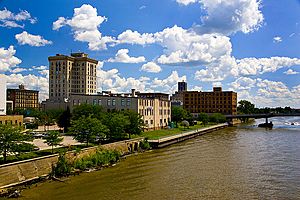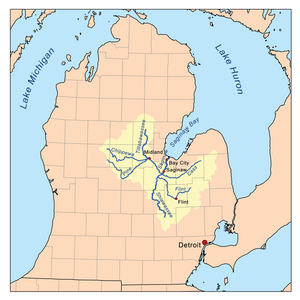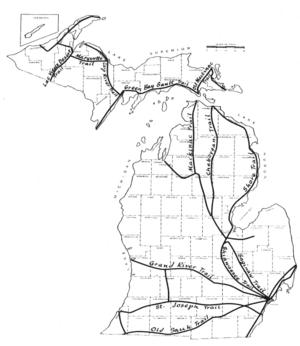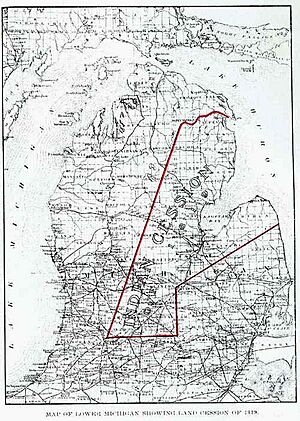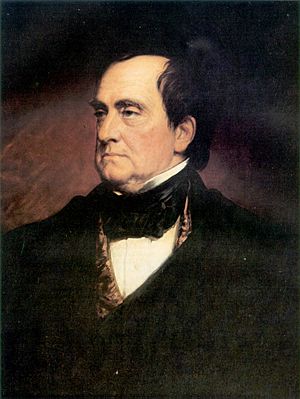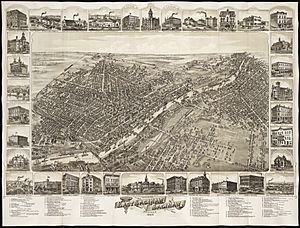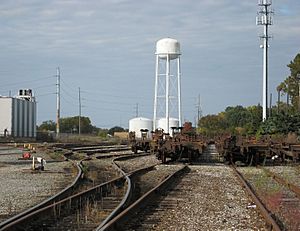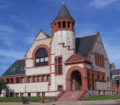History of Saginaw, Michigan facts for kids
The history of Saginaw, Michigan tells the story of how this city grew. It started with Native American hunter-gatherers living in the area. Not many people settled here until the 1800s. That's when the swampy lands were drained to get rid of lots of mosquitoes!
The land where Saginaw now stands was first home to the Anishnabeg people. French missionaries and traders arrived in the late 1600s. They met the Ojibwe (Chippewa) tribe living there. Saginaw was a great meeting place for the "Three Fires" tribes: the Ojibwe, Pottawatomi, and Ottawa. This was because of the easy travel by rivers and Lake Huron.
A Jesuit missionary named Henri Nouvel visited in the 1670s. He wrote about his travels in a journal. Later, Louis Campeau set up a trading post in 1816. The Treaty of Saginaw in 1819 opened the way for more settlers. The U.S. government built Fort Saginaw in 1822 to keep an eye on the Ojibwe. But the mosquitoes and humidity were so bad that the fort closed in 1824!
Saginaw grew a lot because of the huge lumber industry in the 1800s. There were two main towns: Saginaw City and East Saginaw. They joined together to form the city of Saginaw in 1890. The city kept growing when car factories opened. It also helped make supplies for World War II. Many African-Americans moved from the South for factory jobs. This changed the city's population and sometimes caused disagreements. In the late 1900s, Saginaw's economy slowed down as factory jobs decreased. Today, the city is focusing on new ideas, clean energy, and making things for export.
Contents
Early Days of Saginaw
Native American Life
People lived in the Saginaw area from about 1000 B.C. to 1000 A.D. These were the Hopewell Woodland people, followed by the Anishnabeg. Some historians think the Sauk people once lived here. They believe the Ojibwe later moved them out, before Europeans arrived.
The Saginaw region has many rivers and streams. They all flow into the Saginaw River. This made it easy for Native Americans to travel between settlements and hunting areas. It also gave them access to Lake Huron. Saginaw was a common meeting spot for the Ojibwe, Ottawa, and Pottawatomi tribes. These three tribes were known as the "Three Fires" of the Anishnabeg. The name "Saginaw" likely comes from Ojibwe words. It means "place of the outlet" (from "sag" for opening and "ong" for place).
The area that is now Saginaw City was mostly a temporary settlement. This might be because the land was low and often flooded. Much of it was marshland before it was drained in the 1800s. Mosquitoes were a big problem in the area.
French Explorers and Missionaries
French missionaries first came to the area in the 1600s. Henri Nouvel, a Jesuit missionary, was very important. He visited the Native Americans here many times. He wrote about his travels in his journals during the 1670s.
Becoming Part of the United States
France controlled the land that is now Michigan. But they gave it to the British after the Seven Years' War in 1763. The French had built towns around the Great Lakes. But most of Michigan's Lower Peninsula, including Saginaw, was not developed. Both the French and British mostly kept settlements for trade or defense. Saginaw wasn't a key spot for either.
After the British lost the American Revolutionary War, Michigan was given to the United States in 1784. But the British still controlled the area for a long time. It wasn't until after the War of 1812 that all British soldiers left Michigan.
The 1800s: Growth and Change
First Settlements and Trading Posts
The first lasting settlement by white people was a fur-trading post. Louis Campau set it up in 1816 on the west side of the Saginaw River. The U.S. government bought most of the land from Native Americans. This happened with the Treaty of Saginaw in 1819. It cleared the way for more settlers to move in.
Fort Saginaw is Built
In 1822, the U.S. Army used the trading post to build Fort Saginaw. Its purpose was to control the Ojibwe tribe in the area. But the conditions were very bad. There was intense humidity and many mosquitoes. Because of this, the Fort was left empty by 1824.
Saginaw City and County Begin
On September 10, 1822, Governor Lewis Cass officially created the borders for Saginaw County. It was connected to Oakland County for a while. This was until enough people lived there to start its own government. The county's first borders included parts of what are now Bay, Midland, and Shiawassee counties.
Louis Campau planned out a town in 1823. He called it "Town of Sagana." But not many land plots were sold. The town didn't grow much for about ten years. It was re-planned in 1830. Still, plots sold slowly. By 1835, only 24 had been sold. Many early European settlers in Saginaw married Ojibwe women. For example, Jacob Gradroot, an early settler, married the daughter of an Ojibwe leader.
Over the years, parts of Saginaw County were separated to form other counties. In 1831, a part became Midland County. In 1835, a part became Genesee County. In 1857, a northern part became Bay County.
In 1830, the Township of Saginaw was created. It covered all of Saginaw County. In 1835, the county government for Saginaw County officially started. Four years earlier, in 1831, Governor Cass chose the future City of Saginaw as the county seat.
The Lumber Boom
The main reason Saginaw grew was the huge need for lumber in America. Most of Michigan was covered in tall white pine trees. The Saginaw River and its many smaller rivers made it easy to move logs. This led to a huge increase in people and business. Trees were cut down and floated to sawmills in Saginaw. From there, the lumber was loaded onto ships and later trains.
What is now Saginaw City was once several smaller towns. On the west side of the river, the first settlement around Fort Saginaw became "Saginaw." It became a city in 1857 and was the county seat. On the east side, "East Saginaw" grew. It became a village in 1855 and a city in 1859. South of East Saginaw was the village of Salina. Its name came from the salty water used to make salt. Both Saginaw and East Saginaw quickly became important train hubs, along with river shipping. Another sawmill town called Florece was also on the east side and later joined Saginaw.
Lumber production was highest in the early 1870s. It almost completely stopped by the end of the 1800s. Salt production also slowed down. But new industries grew, supporting farming and manufacturing.
East and West Sides Join Together
On June 28, 1889, Michigan's government passed a law. It joined the City of Saginaw and the City of East Saginaw into one new city, also called Saginaw. Before this, the village of Salina had already joined East Saginaw. The new City of Saginaw officially started on March 12, 1890, when new leaders were elected.
The city was run by a city council. It had two aldermen elected from each of 21 areas, plus a mayor. The mayor didn't have much power. Many other elected or appointed groups controlled how the city was run. There were still rivalries between people and businesses from the old two cities. These differences between the east and west sides of Saginaw lasted for a hundred years. They still affect Saginaw's politics and economy today.
The 1900s: Industry and Change
A City of Factories
At the start of the 1900s, many cities in Michigan began making cars. Saginaw was one of them. The Jackson, Wilcox and Church Company first made horse-drawn carriages. Later, they made parts for cars. This company was bought by General Motors. It became the basis for their Steering Gear division. General Motors also built other factories in Saginaw. These early car factories shaped Saginaw's future economy.
Saginaw's Mid-Century Boom
When the United States entered World War II, Saginaw's factories helped the war effort. They made ammunition and parts for military vehicles. Saginaw was a big help to the country's victory. One factory in Saginaw made over half a million M1 Carbine rifles for the U.S. Military during the war.
Many workers moved to Saginaw from other parts of the U.S. They came from areas hit hard by the Great Depression, especially the South. This migration continued through the war and the good economy that followed. Saginaw, like most of America, did very well after the war. General Motors grew its presence in Saginaw, and other factories also made more goods. This caused the city's population to reach its highest point, about 100,000 people, in the 1960s.
The growing city needed better services. Saginaw invested a lot in its infrastructure. For example, Saginaw built a 65-mile-long pipeline in 1947. It brought water from Lake Huron to meet the city's needs. Also, the cities of Midland, Bay City, and Saginaw worked together. They built and started an airport nearby. This is now MBS International Airport.
Late 1900s: Challenges and New Focus
After World War II, Michigan passed laws that made it harder for cities to grow. Cities couldn't easily add nearby township land. Townships, which used to be rural, could now offer almost all the same services as cities. Houses were built in nearby townships. Saginaw started selling water to these townships with long-term contracts. This helped the townships grow even more. But it also meant Saginaw's population stopped growing, and new housing development slowed down in the city itself.
As workers moved from other parts of the U.S., especially the South, Saginaw's African-American population grew a lot. Sadly, racism led to the separation of African-American residents. They were mostly in neighborhoods on the city's east side. Banks and real estate agents used unfair practices called "redlining." This controlled where African-Americans could live. Over time, most white residents on the east side moved to the west side or to nearby townships. The Saginaw River became a symbol of this separation.
Later, rules that forced segregation ended. African-Americans had more opportunities. The west side of Saginaw became much more diverse. It no longer had only white residents.
The number of factory jobs went down. This led to high unemployment rates. Property values also dropped, which meant the city collected less money from property taxes. Saginaw saw an increase in crime. At the same time, the city had to make its police department smaller. Overall, the city government now has almost half the number of employees it had in the 1970s.
Today, Saginaw is focusing on new ways to grow its economy. It looks at new ideas, clean energy, and continuing to make things for export. Compared to other mid-sized cities, Saginaw has many patents per employee. It also has many more jobs in solar energy research and production. The city still has more manufacturing jobs than the average U.S. city.
Images for kids
-
The old East Saginaw Post Office is now the Castle Museum of Saginaw County History.


